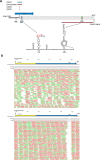The Expression and Nuclear Retention Element of Polyadenylated Nuclear RNA Is Not Required for Productive Lytic Replication of Kaposi's Sarcoma-Associated Herpesvirus
- PMID: 33853955
- PMCID: PMC8315919
- DOI: 10.1128/JVI.00096-21
The Expression and Nuclear Retention Element of Polyadenylated Nuclear RNA Is Not Required for Productive Lytic Replication of Kaposi's Sarcoma-Associated Herpesvirus
Abstract
Kaposi's sarcoma-associated herpesvirus (KSHV) is an oncogenic human gammaherpesvirus and the causative agent of Kaposi's sarcoma (KS), primary effusion lymphoma (PEL), and multicentric Castleman's disease (MCD). During reactivation, viral genes are expressed in a temporal manner. These lytic genes encode transactivators, core replication proteins, or structural proteins. During reactivation, other viral factors that are required for lytic replication are expressed. The most abundant viral transcript is the long noncoding RNA (lncRNA) known as polyadenylated nuclear (PAN) RNA. lncRNAs have diverse functions, including the regulation of gene expression and the immune response. PAN possesses two main cis-acting elements, the Mta response element (MRE) and the expression and nuclear retention element (ENE). While PAN has been demonstrated to be required for efficient viral replication, the function of these elements within PAN remains unclear. Our goal was to determine if the ENE of PAN is required in the context of infection. A KSHV bacmid containing a deletion of the 79-nucleotide (nt) ENE in PAN was generated to assess the effects of the ENE during viral replication. Our studies demonstrated that the ENE is not required for viral DNA synthesis, lytic gene expression, or the production of infectious virus. Although the ENE is not required for viral replication, we found that the ENE functions to retain PAN in the nucleus, and the absence of the ENE results in an increased accumulation of PAN in the cytoplasm. Furthermore, open reading frame 59 (ORF59), LANA, ORF57, H1.4, and H2A still retain the ability to bind to PAN in the absence of the ENE. Together, our data highlight how the ENE affects the nuclear retention of PAN but ultimately does not play an essential role during lytic replication. Our data suggest that PAN may have other functional domains apart from the ENE. IMPORTANCE KSHV is an oncogenic herpesvirus that establishes latency and exhibits episodes of reactivation. KSHV disease pathologies are most often associated with the lytic replication of the virus. PAN RNA is the most abundant viral transcript during the reactivation of KSHV and is required for viral replication. Deletion and knockdown of PAN resulted in defects in viral replication and reduced virion production in the absence of PAN RNA. To better understand how the cis elements within PAN may contribute to its function, we investigated if the ENE of PAN was necessary for viral replication. Although the ENE had previously been extensively studied with both biochemical and in vitro approaches, this is the first study to demonstrate the role of the ENE in the context of infection and that the ENE of PAN is not required for the lytic replication of KSHV.
Keywords: ENE; Kaposi’s sarcoma-associated herpesvirus; PAN RNA; lncRNA.
Figures






References
Publication types
MeSH terms
Substances
Grants and funding
LinkOut - more resources
Full Text Sources
Other Literature Sources
Research Materials

